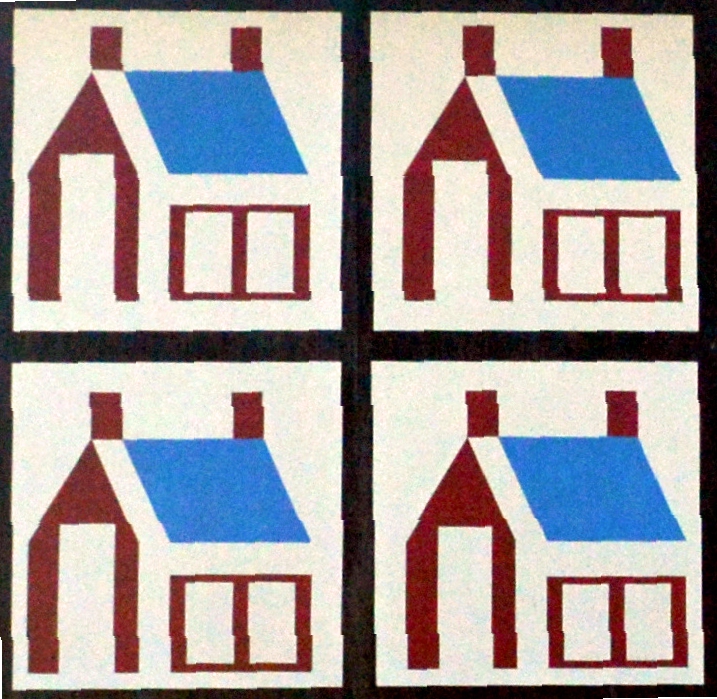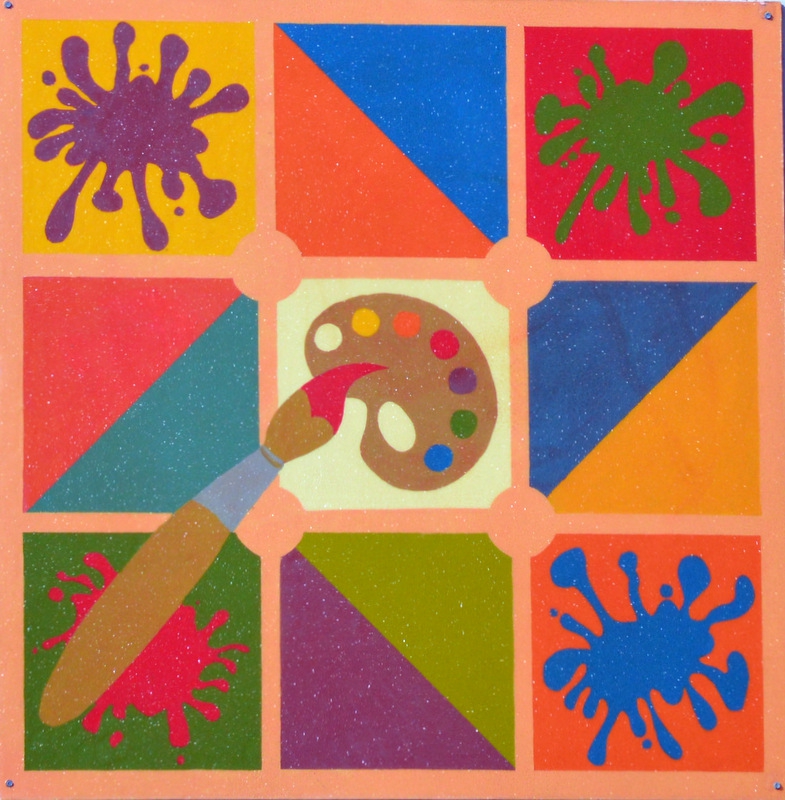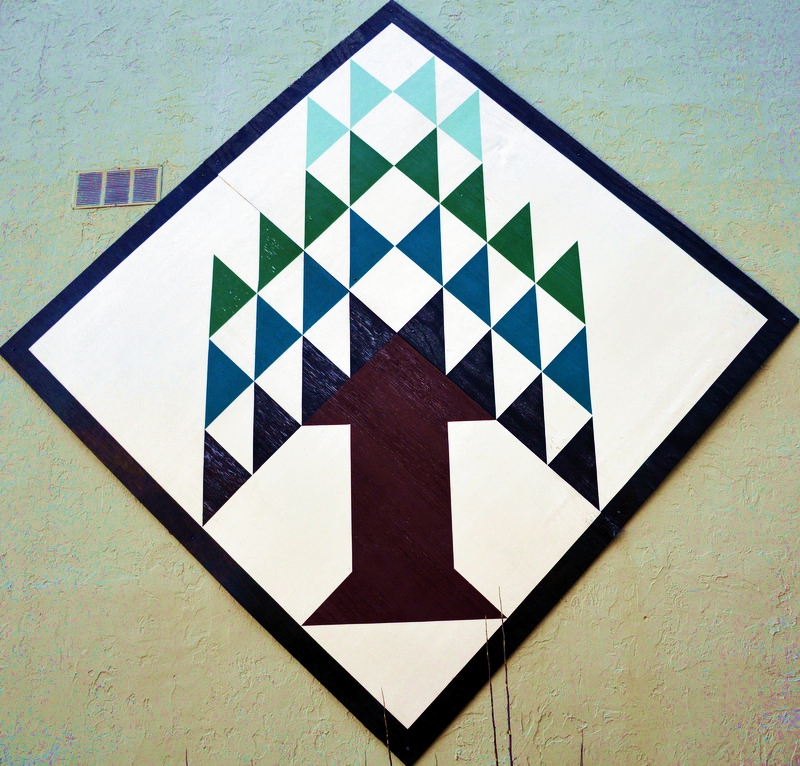Mural Tour Guide of High Springs Florida
The Walldogs Historic Mural Trail
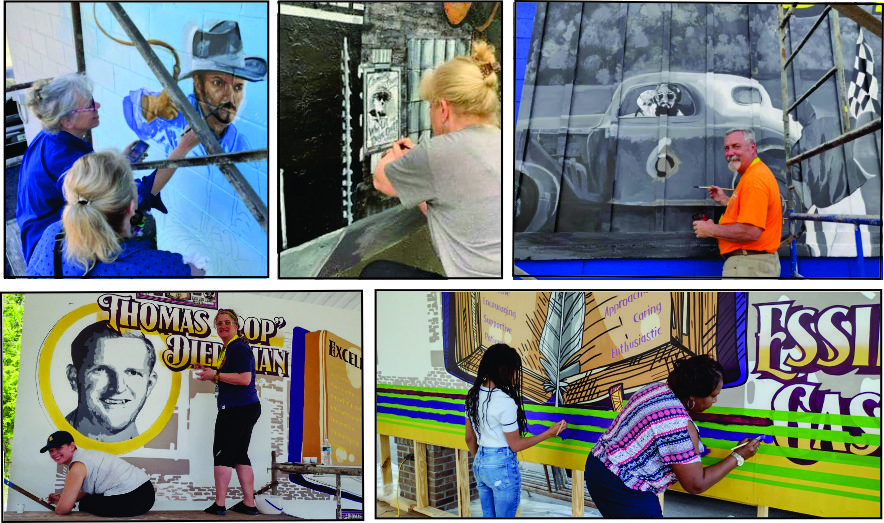
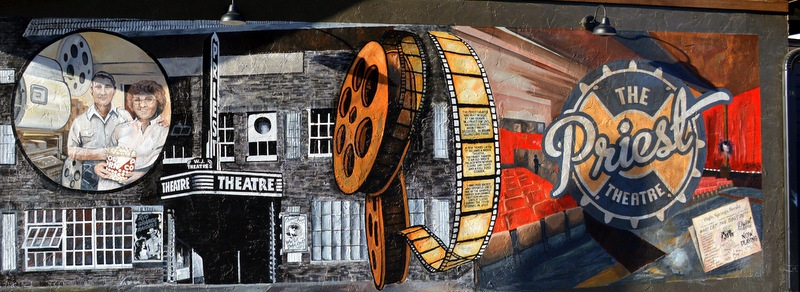
#114 The Priest Theater – located at 18559 NW 237th ST, facing the rail corridor.
“The Priest Theatre,” has quite the history. It was built in 1910 for vaudeville shows in High Springs, Florida by William Jefferson Priest, who also owned the Priest Ford Motor car dealership.
It was used for storage for the Priest Ford Motor dealership for a while when traveling vaudeville shows ceased. But after much research into the architecture and construction of the building, we found that the original purpose of the tall, cavernous building was for entertainment. The building includes a large open lobby and also a large auditorium that seats 240 people, along with a balcony, sloping floors in the main auditorium, a main entrance from the front and a side door entrance that led to the balcony, a balcony restroom, lobby restrooms for men and women, a complete raised stage including an arched opening with two great columns on both sides of the stage and stairs on opposite sides of the stage that led to the actors’ dressing rooms.
Eventually vaudeville and live performances were replaced with silent movies and music; usually a piano was used as accompaniment. Then in 1927 silent movies upgraded to “talkies” with the first commercially successful one being The Jazz Singer. As time progressed, people were enjoying the cinema and Hollywood was growing into a huge business. By the 1950’s, the Priest Theatre’s venue included up to five different movies each week.
In 1986, Janice and Bobby Sheffield bought the Priest Theater and their family ran the theater until 2020 when the Covid pandemic shut down the movie industry. Prior to the Pandemic, the priest was the oldest operating movie theater in the State of Florida.
Post Covid a number of structural concerns forced the theater to cease operating. Until 2020, the Priest was the longest continually operating theater in the state of Florida. Efforts to preserve this building and prepare it for a new purpose are ongoing.
The great grandchildren of the Sheffields helped paint this mural and the artists put their names on the “newspaper” in the mural. This building was home to the High Springs Herald for many years and the illustration of the newspaper was added at the request of the building owner, Prohibition Pizza.
This mural was completed by the Walldog artists in March 2023. This mural was designed by Walldog artist Michael Clark, from Aledo, Illinois.

#119 Old Bellamy Road, – located at Thompson’s Flower Shop at 18767 High Springs Main St., North Wall
The oldest existing road in America runs through High Springs. While some of the road has disappeared due to development or abandonment, sections still exist. It is named after John Bellamy, the contractor and Florida plantation owner who built it in 1825 through 1826. But the history of the road goes back centuries earlier. History shows Spanish explorers and missionaries used the trail in the 1500’s and 1600’s as a trail across north central Florida.
On Dec. 18, 1824, Florida plantation owner John Bellamy entered a bid to build the section of the new road between the St. John’s River near St. Augustine and the Ochlockonee River near the new territorial capital of Tallahassee. He could complete the project, he believed, for $13,500. The bid was accepted and in early 1825 work began on laying out, clearing and building the road.
The congressional act had stated that the road was to be 25 feet wide to allow two wagons to pass each other, but the contract with Bellamy required that the road only be 16 feet wide. Tree stumps were to cut as close to the ground as possible, in order to clear a wagon’s axles. Travelers quickly complained that the road was not always wide enough to let two wagons pass, that the bridges were inadequate, and that some stumps, “stump knockers,” were too tall, jolting passengers and breaking axles. The road became known as Stump Knocker Road.
By May 1826, “Bellamy’s Road” was completed and became the main route for travel between Tallahassee and Saint Augustine prior to the Civil War. By the 1860s, Florida’s population and settlements had grown and other routes, as well as train travel, began to make Bellamy Road less traveled, and by the 1890s it was no longer being used except by local residents. Over the next century it fell into disrepair and portions disappeared as nature reclaimed the land.
But portions of Old Bellamy Road still exist today, with much of it either running through rural residential neighborhoods or buried under newer asphalt roads. In eastern Alachua County, the road follows the Old Mission Trail on the south end of Lake Santa Fe and part of State Road 26 in Melrose. Another easily accessible remnant is part of the O’Leno State Park and the overland pass of the Santa Fe River. From there, the road passes out of Alachua County toward Tallahassee. For a trip through the early history of Florida, visitors can still drive a section of the original road as they make their way to the Bellamy Road Interpretive Trail at River Rise Preserve State Park just north of High Springs. Open daily, the trail follows the trace of the old road and includes panels detailing its history. To reach the trail, travel from High Springs on U.S 41/U.S. 441 North for 5.6 miles then turn right on Old Bellamy Road SE. Follow it to the end
This mural was completed by the Walldog artists in March 2023. This mural was designed by Walldog artist Tom Paux, Pensacola Florida
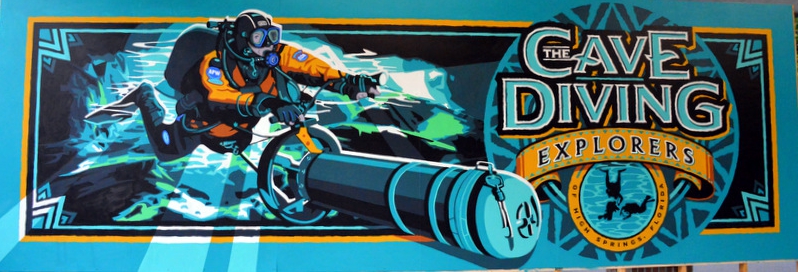
#116 Cave Diving Explorers – this will be located on the north side of Global Underwater Explorers at 18487 High Springs Main St.
The development of cave diving as a sport has roots here in High Springs due to the caves in the nearby Santa Fe River. The cave systems in the region spawned exploration and development of equipment by world class explores such as Sheck Exley and Wes Skiles who increased our understanding about underground water flow through underground rivers and caves.
Underwater cave explorers continue to increase our understanding of our planet’s hydrology. Braving life threatening conditions, these explorers help us experience and learn the inner workings of our planet.
The cave systems located at Ginnie Springs, Wes Skiles Peacock State Park and Little River are world renowned cave dives with thousands of cave divers visiting every year. The large tunnels, crystal clear and warm water found year round attract cave divers to learn and explore.
This mural was completed by the Walldog artists in March 2023. This mural was designed by Walldog artists Ben & Joe Diaz from Pontiac, Illinois

# 106 –
Plant Railroad Division Headquarters is located on the south side of Good News Arts in the former Dean Davis building owned by Two Finger Properties. Kelly Barber, owner of Raymond James made this mural possible.
The Plant Investment Company was formed in 1882 to lease and buy other railroads and expand the system. IN 1895, High Springs was selected as the headquarters of the Plant Railroad. High Springs had a spring which provided water to the steam engines. At one time, there were train repair shops, hotels, a roundhouse and a company hospital that served the railroad workers. High Springs flourished as a railroad town.
While facing the mural, the area behind you was lined with multiple rail lines, one of which operated until 2017. In the distance to your left is where the roundhous foundations can still be found.
The various lines of the Savannah, Florida & Western were consolidated into one company in 1884. Under the Savannah, Florida & Western corporation was the Live Oak, Tampa and Charlotte Harbor Railroad was a historic railroad in Florida chartered by railroad tycoon Henry B. Plant. It was built as an extension of Plant’s Live Oak and Rowlands Bluff Railroad. Together, the two lines ran from Live Oak, Florida to Gainesville via High Springs. The lines were completed in 1884.
In 1902 the Atlantic Coast Line Railroad acquired the entire Plant System, connecting at Charleston, SC. The components were soon merged into the ACL. The system has since become part of CSX after several mergers.
This mural was completed by the Walldog artists in March 2023. This mural was designed by by Walldog artists: Dan Luckin from Chelmsford, Essex, United Kingdom and Ross Hastie from Alloa, Scotland
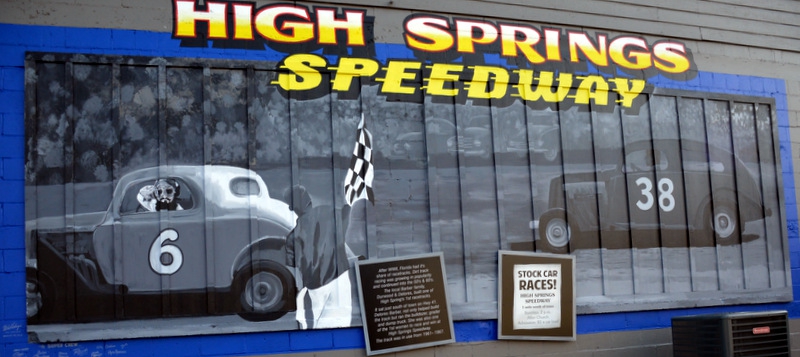
#115 High Springs Speedway – located at 23560 NW NW 185th Rd.-rear of building, facing NW 235th St – tucked into an inset
This mural was completed by the Walldog artists in March 2023. This mural was designed by Walldog artist Sam Sanfilippo from Pinson, Alabama

#117 Educators/Civic Leader Mural, this mural will be located at The Old School 18731 NW 238th St.
Essie Gassett and Thomas Diedeman dedicated their lives in service to High Springs.
Essie Gassett taught for over 32 years at both the Douglass school and at High Springs Elementary school.
She served on the Prevention Council of Substance and Alcohol Abuse,and volunteered on the Martin Luther King, Jr., Commemorative Committee. She was a basketball coach, a member of High Springs Community Development Organization as well as American Association of Retired Persons. Essie was the founder of High Springs Child Care Center, which served the Douglass Community for over 50 years. In her role as a civic leader, she was a member of the League of Cities and Alachua County Tourist Development Council. She was the first African American female commissioner and the first African American female mayor for the City of High Springs. When this mural was completed, Essie’s family gathered to honor her legacy and shared stories with us. This remarkable woman graduated from Bethune Cookman College at the age of 21 and already had 4 children.
Tom Diedeman served in the U.S. Navy where he served as a Sonarman Third Class. From 1943- 1946, Tom spent most of his stellar service career in the Pacific Theater on the USS Frament, a Destroyer Escort. After his service, Tom returned to Gainesville and earned both his Bachelor of Science and Master of Education from the University of Florida. He began his teaching career in High Springs serving High Springs High School as science teacher and coaching football. This is where he got the nickname “Pop” Diedeman from his students. He also developed recreation programs and he spent many summers taking the school bus to Poe & Blue Springs, and to Glen Springs, where he taught many High Springs children swimming lessons & also made trips to the skating rink in Gainesville. They occasionally hiked to Poe or Underwood Hill.
In 1956, he became Principal of High Springs Elementary, which was in what is now the City of High Springs Old School Community Center. During the era of integration, the middle school was housed at Douglas until Spring Hill was completed in 1971 He and Mr. Furman Welch led the High Springs schools through the era of integration and together, these two men led “the most peaceful transition of all the schools during integration”.
In 1970 he was instrumental in working with UF to transition from a junior high school system to establishing one of the first middle schools in the State of Florida. Tom oversaw the planning, development and building of Spring Hill Middle School and became principal there in 1970. He retired from Spring Hill Middle in 1990 after a career which spanned over 40 years in education that was spent solely in the city of High Springs.
Tom was a member of the High Springs Rotary Club where he received the Paul Harris Fellow, including over 30 years of perfect attendance. He was a member of Springhill Methodist and First United Methodist of High Springs. Tom was elected as a High Springs City Commissioner and served as Mayor of High Springs from 1970-71. He loved the City of High Springs and the surrounding area. Poe Springs was one of his favorite spots, where he taught hundreds of kids how to swim. He had a passion for education and wanted the best for all his students and teachers.
This mural was completed by the Walldog artists in March 2023. This mural was designed by Walldog artist Jim Dawson from Strasburg, Ohio
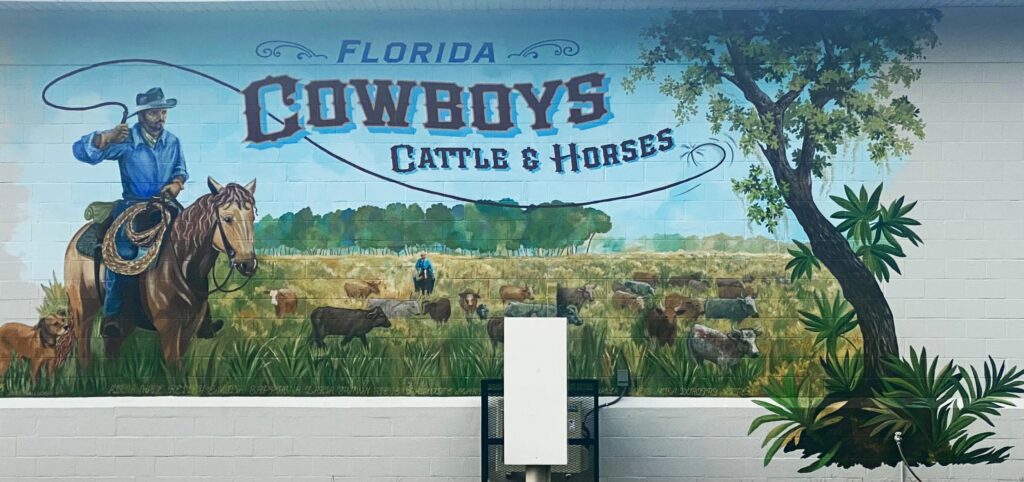
# 118 Florida Cowboys – located at Duke Energy building 23074 NW 186th Ave – South side of the building facing US 27. Duke energy funded and sponsored this mural to make sure contributions of the Florida Cowboy are recognized.
To a Florida native, being called a “Cracker Cowboy” is a compliment. It recalls the grit and tenacity of laboring cowboys who became known for the thunder-like “cracks” of their whips to audibly steer cattle over large open spaces. Many associate the cowboy with the Wild West, but few know that these bullwhip-toting ancestors shaped the landscape, history and economy that make Florida what it is today.
Spain’s attempts to colonize the interior of Florida were abandoned by the early 1700s. Spanish colonists retreated to the fortress towns of St. Augustine and Pensacola or departed for their Caribbean holdings in Cuba and Hispaniola (the island now made up of the Dominican Republic and Haiti), leaving behind massive herds of Andalusian cattle, an ancestor of today’s modern Texas longhorn. Prized for the hardiness and resistance to parasites the breed had developed living in Florida, these cattle were turned loose or escaped their enclosures, multiplying and spreading across North America in record numbers. The cattle drove Florida’s economy for much of the 19th century and helped create today’s state economy. Without these cattle, the cracker cowboy, the most mythic of the Florida frontiersmen, would not have existed.
Battles fought between indigenous Native Americans and the Spanish and English settlers in Florida were fueled to no small degree by the various cattle rustlers on both sides who sought to control the large, wild herds of the interior and the land they grazed on. Ahaya, “the Cowkeeper” and the first chief of the Alachua band of the Seminole tribe, took territorial control of modern-day Paynes Prairie and an abandoned Spanish cattle ranch in the early 1700s, quickly amassing enough wild cows to earn his namesake. The village he and his people established before his death in 1784, Cuscowilla, later became the first established American town in the Florida territory under its current name, Micanopy. Rather than import or drive more cattle into Florida, the two sides instead warred over the existing population until the settlers were able to displace the natives.
During the Civil War, cracker-supplied cattle were the Confederate Army’s chief source of meat, leather and hides, particularly after Union ships blockaded southern ports. Forced to drive the animals by land into Georgia, the “Cow Cavalry” faced harsh conditions and the occasional skirmish with Union forces along the way, prompting some to turn sides and sell their cattle to the Union-controlled port of Fort Myers.
Florida’s unpredictable weather, from never-ending downpours to oppressive heat, was just one challenge the cracker cowboys faced on the trail. They also had to take care to avoid dangerous panthers, mosquitoes, bears and wolves and hostile native tribes with nothing but small packs of herd dogs for protection.
As barbed-wire cattle farms started to offer more consistent beef, the roaming Florida cracker faded into history, but their stories and the culture they embodied can still be felt here in Central Florida. In 2000, the White House Millennium Council selected the Florida Cracker Trail as a “Millennium Trail,” recognizing both its historical and cultural importance to the state and the nation.
This mural was completed by the Walldog artists in March 2023. This mural was designed by Walldog artists Alicia Rheal, Madison Wisconsin
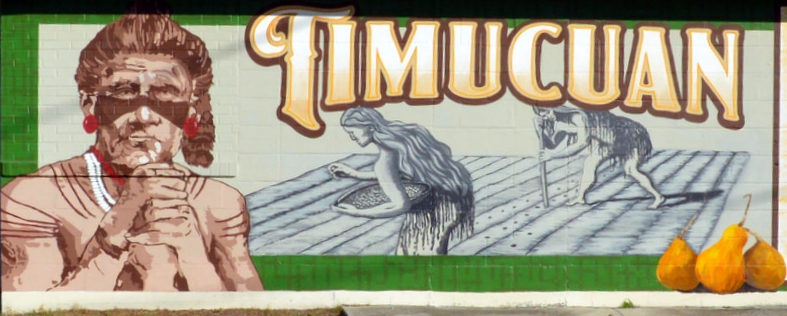
#113 Indigenous Indians – located on the Windstream building at 18578 NW 237th St.
The Timucua Indians were the area’s first farmers and fishermen and their agricultural skills were legendary. The Timicuans numbered about 200,000 and occupied 19,200 square miles in what is now northern Florida and southern Georgia.
The people suffered severely from the introduction of Eurasian infectious diseases. By 1595, their population was estimated to have been reduced from 200,000 to 50,000 and thirteen chiefdoms remained. By 1700, the population of the tribe had been reduced to an estimated 1,000 due to slave raids from Carolinian settlers and their Indian allies. The local slave trade completed their extinction as a tribe soon after the turn of the 18th century.
A census in 1711 found 142 Timucua-speakers living in four villages under Spanish protection. Another census in 1717 found 256 people in three villages where Timucua was the language of the majority, although there were a few inhabitants with a different native language. The population of the Timucua villages was 167 in 1726. By 1759 the Timucua under Spanish protection and control numbered just six adults and five half-Timucua children.
In 1763, when Spain ceded Florida to Great Britain, the Spanish took the less than 100 Timucua and other natives to Cuba. Some historians believe a small group of Timucua may have stayed behind in Florida or Georgia and possibly assimilated into other groups such as the Seminoles. Many Timucua artifacts are stored at the Florida Museum of Natural History at the University of Florida and other museums.
This mural was completed by the Walldog artists in March 2023. This mural was designed by Walldog artist Robert Estes from Paducah Kentucky.

#112 Santa Fe River is located on the south side of the Air America building, next to the fire station and across from the Library.
The Santa Fe River runs 75 miles from Lake Santa Fe to the Suwannee River. The paddling trail is 26 miles long and has over 35 springs. The unusual Karst rock formation in this area creates underwater caves and the river even disappears underground and then reappears 3 miles later near O’Leno park, just north of High Springs.The river is home to diverse wildlife and people come from all over the globe to enjoy the river and springs.
The High Springs area is home to the largest collection of First Magnitude fresh water Springs in the world. A First Magnitude Spring produces over 64 million gallons of water per day.
The mural depicts Dunagan’s Mill which was built in 1895 and run by Abner Dunagan and his family. The grain and grist mill was located in the lower part, while a sawmill occupied the upper part of the structure.The mill was located near Poe Springs.
Also depicted in the mural are Lily and Poe Springs. These springs are where local children spent their summers and learned to swim.
Poe Springs is currently owned by Alachua County and operated as a county park, so families still enjoy the spring waters at that location. It produces about 45 million gallons of water daily and the spring vent is 25 feet deep.
This mural was completed by the Walldog artists in March 2023. This mural was designed by Walldog artist Doug Haffner of Wyoming Illinois.
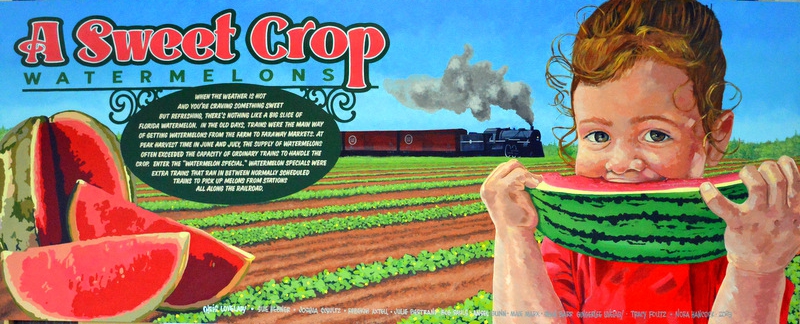
#120 Agriculture/Watermelon – located at United Country Real Estate 19064 NW US Highway 441
Early settlers planted crops of sugarcane, peanuts, cotton, tobacco and watermelon to supplement their income. High Springs became home of a large Peanut Mill and boasted Tobacco warehouses which allowed farmers to easily sell the crops they grew.
European colonists brought the seeds to North America, and it is thought that both Spanish settlers and Native Americans were growing watermelons in Florida as far back as the late 1500s. Watermelon needs warm temperatures and can tolerate high humidity, making it a perfect crop for Florida.
The owner of this building is a 5th generation watermelon farmer in this area and requested the mural focus on watermelon which remains a major regional crop.
This mural was completed by the Walldog artists in March 2023. This mural was designed by Walldog artist Chris Lovelady from Thomasville, Georgia
Local Neighborhood Mural Tour



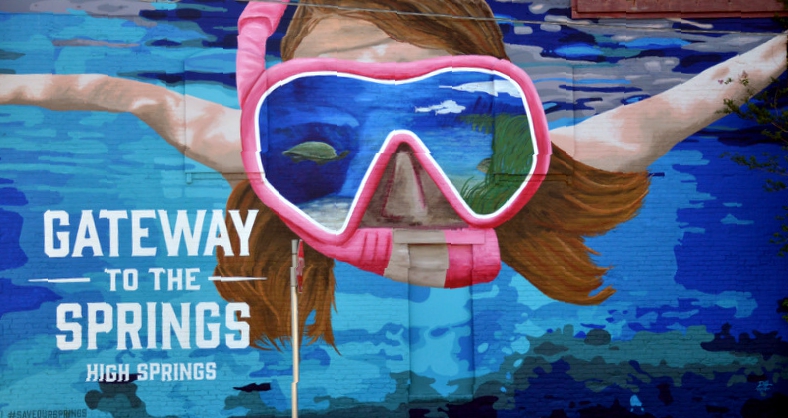
Quilt Mural Tour
